Back to JANUS Applications
1.0 Physical Properties Application
The Physical Properties application allows you to retrieve files generated by Lab Viewís Velocity and Shear and Moisture Density applications and upload these files into Janus.
NOTE: The transfer function of this application can only be run on a Macintosh. All physical properties files reside on a Novell server named GROSBECK under the directory GROSBECK.DATA1:JANUS_Q. Under this directory are subdirectories corresponding to each sensor (AVS, GRAPE, MAD, NGR, PWL, PWS1, PWS2, PWS3, WC-MS) as well as a subdirectory named STANDARDS in which all the standards files are kept. Also on this server is a directory named GROSBECK.DATA1:TRNFRD. After files are successfully uploaded, they are moved from the JANUS_Q hierarchy to the TRNFRD hierarchy. As each file is transferred, its entire directory structure is reproduced under TRNFRD, so the TRNFRD directory structure mirrors JANUS_Q. It is important that the JANUS_ Q subdirectories are properly named, otherwise those directories are not scanned for data files.
Open Physical Properties by selecting the Physical Properties option from the Application menu of the main Ocean Drilling Program - Janus window. It is shown below.

ODP - Physical Properties Application Window
1.1 File
The only File option for Physical Properties is:

1.1.1 Exit Physical Properties
Use the Exit Phys Props option in the File menu is to leave the Physical Properties application and return to the Ocean Drilling Program - Janus window.
1.2 Transfer
The Transfer menu contains functions that transfer data into the Janus.

1.2.1 Moisture Density Files (Moisture Density Data Files -- Window phy01)
The Moisture Density Data Files window allows you to retrieve moisture density files generated by Lab View and load them into Janus. This function can only be done on the Macintosh. Open the window by selecting the Moisture Density Files option from the Transfer menu.
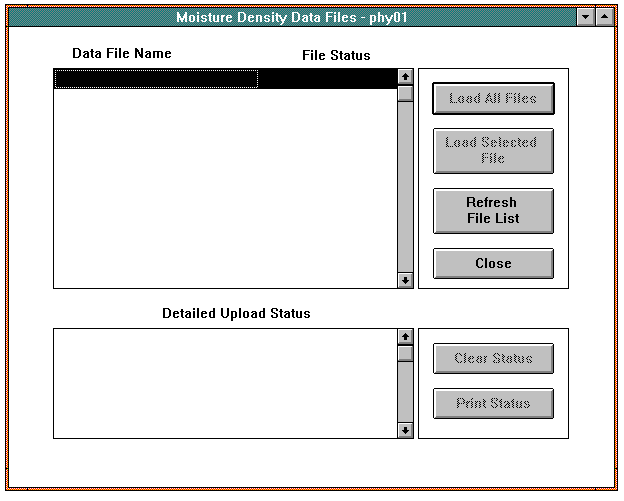
Moisture Density Data Files Window
The Moisture Density data files are expected to reside under the path GROSBECK.DATA1:JANUS_Q in the subdirectory MAD. If the GROSBECK.DATA1 volume is not mounted on the client, or if either of the GROSBECK.DATA1:JANUS_Q or GROSBECK.DATA1:TRNFRD directories are not present, then the application asks you to specify alternate locations for the missing directories. If you cancel out of selecting the alternates, then the window comes up an empty list box and only the Refresh File List and Close buttons is enabled. If the required directories are present, or if alternates were selected, then the window opens and is populated with Data File Name and Upload Status of all available Moisture Density files. The Detailed Upload Status field is blank.
During an upload, the file that is currently being loaded is highlighted in the top list box. The Detailed Upload Status list box at the bottom shows the status of that file. File status are: Awaiting Transfer; Reading...; Loading...; Transferring...; No Action; Transferred; or Error. If an error occurs while transferring a file, that file stays in the queue (and still be displayed in the list box) until the problem is resolved and it can be transferred successfully. To find out what caused the error in transferring data, locate the janus.errlog file on your system. This aids in tracking down the problem with the file.
If you wish to do another transfer, rescan the Lab View directories for new moisture density Lab View files using the Refresh File List button. After the directories are scanned for new files, you can do another upload of files. Any files left from the last transfer is still displayed in the list box.
Buttons
 Clicking on this button initiates the upload of all of the moisture density files that are listed in the window. They is loaded into a Janus-related directory. NOTE: After all files are loaded, the button becomes inactive until you refresh the file list
Clicking on this button initiates the upload of all of the moisture density files that are listed in the window. They is loaded into a Janus-related directory. NOTE: After all files are loaded, the button becomes inactive until you refresh the file list
 After a transfer, use this button to rescan all directories for new moisture density Lab View files. The button is inactive when the window opens and becomes active after a transfer.
After a transfer, use this button to rescan all directories for new moisture density Lab View files. The button is inactive when the window opens and becomes active after a transfer. This button closes the window.
This button closes the window. When you click on this button, the Detailed Upload Status list box cleared.
When you click on this button, the Detailed Upload Status list box cleared. Use this button to print the contents of the Detailed Upload Status list box.
Use this button to print the contents of the Detailed Upload Status list box.
1.2.2 Velocity and Shear Files (V & S Data Files -- Window phy02)
The V & S Data Files window allows you to retrieve velocity and shear strength data files generated by Lab View and load them into Janus. This function can only be done on the Macintosh. Open the window by selecting the Velocity and Shear Files option from the Transfer menu.
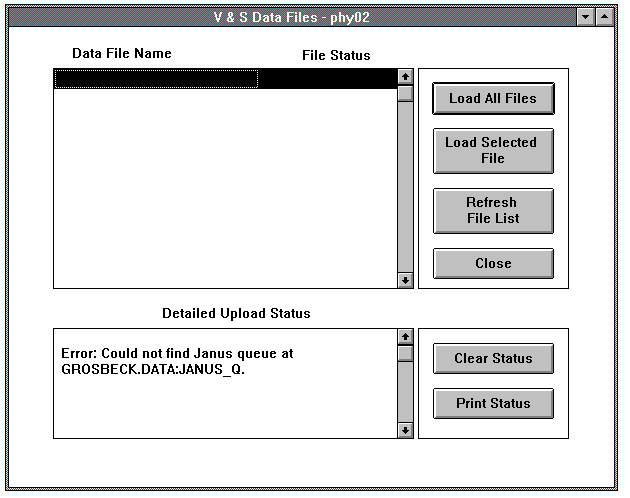
V & S Data Files Window
The Velocity and Shear (V & S) data files are expected to reside under the path GROSBECK.DATA1:JANUS_Q in the subdirectories AVS, PWS1, PWS2, and PWS3. If the GROSBECK.DATA1 volume is not mounted on the client, or if either of the GROSBECK.DATA1:JANUS_Q or GROSBECK.DATA1:TRNFRD directories are not present, then the application asks you to specify alternate locations for the missing directories. If you cancel out of selecting the alternates, then the window comes up an empty list box and only the Refresh File List and Close buttons is enabled. If the required directories are present, or if alternates were selected, then the window opens and is populated with Data File Name and Upload Status of all available Moisture Density files. The Detailed Upload Status field is blank.
During an upload, the file that is currently being loaded is highlighted in the top list box. The Detailed Upload Status list box at the bottom shows the status of that file. File status are: Awaiting Transfer; Reading...; Loading...; Transferring...; No Action; Transferred; or Error. If an error occurs while transferring a file, that file stays in the queue (and is still displayed in the list box) until the problem is resolved and it can be transferred successfully. To find out what caused the error in transferring data, locate the janus.errlog file on your system. This aids in tracking down the problem with the file.
If you wish to do another transfer, rescan the Lab View directories for new velocity and shear strength Lab View files using the Refresh File List button. After the directories are scanned for new files, you can do another upload of files. Any files left from the last transfer is still displayed in the list box.
Buttons
 Clicking on this button initiates the upload of all of the velocity and shear strength files that are listed in the window. They are loaded into a Janus-related directory. NOTE: After all files are loaded, the button becomes inactive until you refresh the file list
Clicking on this button initiates the upload of all of the velocity and shear strength files that are listed in the window. They are loaded into a Janus-related directory. NOTE: After all files are loaded, the button becomes inactive until you refresh the file list
 After a transfer, use this button to rescan all directories for new velocity and shear strength Lab View files. The button is inactive when the window opens and becomes active after a transfer.
After a transfer, use this button to rescan all directories for new velocity and shear strength Lab View files. The button is inactive when the window opens and becomes active after a transfer. This button closes the window.
This button closes the window. When you click on this button, the Detailed Upload Status list box is cleared.
When you click on this button, the Detailed Upload Status list box is cleared. Use this button to print the contents of the Detailed Upload Status list box.
Use this button to print the contents of the Detailed Upload Status list box.
1.2.3 Import Thermcon Data File (Import Thermal Conductivity Data File -- Window phy07)
The Import Thermal Conductivity Data File window allows you to import comma delimited thermal conductivity data files into Janus. Open the window by selecting the Import Thermal Conductivity Data File option from the Transfer menu.
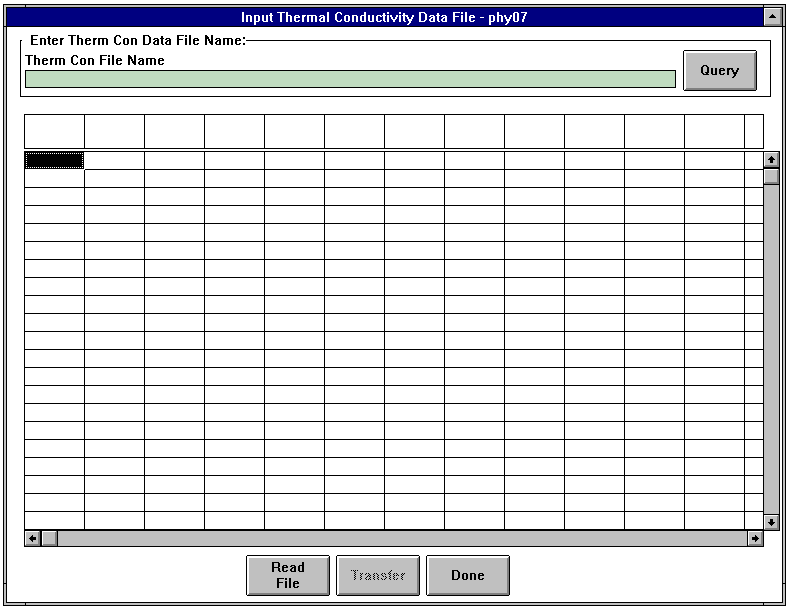
Import Thermal Conductivity Data File
When the window opens, the Thermcon File Name field and the list box is blank. The Thermcon File Name field is used to enter or select a file for import. You can either type in the file name or click on the Query button. This brings up a standard dialog box for file selection. Once you select a file or enter a file name, click on the Read File button to load the data into the list box. When you click on the Read File button, the Physical Properties Upload Status window (see Section 1.2.3.1) appears and displays the status of the file as it loads. If there is an error in the data, it is shown here and the read process stops. The bad data also appears as red text in the list box. When you encounter bad data, it must be corrected in the original spreadsheet before you can successfully load that data into the list box.
After you have loaded the data into the list box and reviewed it for accuracy, transfer it into the Janus database. When you click on the Transfer button, a message appears asking if you wish to overwrite existing data in the database or append the new data to the existing data. To append the new data, you must define a unique sequence ID for the replicate sample ID. Make this change in the original spreadsheet and resubmit the for input to the database.
Buttons
 Clicking on this button accesses the file selection dialog box for the platform on which you are working. A file name selected here appears in the Thermcon File Name field.
Clicking on this button accesses the file selection dialog box for the platform on which you are working. A file name selected here appears in the Thermcon File Name field.  Clicking this button begins the process of reading the selected file into the list box. The Physical Properties Upload Status window (see Section 1.2.3.1) appears and displays any errors encountered during the read process. The process aborts when invalid data is encountered.
Clicking this button begins the process of reading the selected file into the list box. The Physical Properties Upload Status window (see Section 1.2.3.1) appears and displays any errors encountered during the read process. The process aborts when invalid data is encountered. NOTE: This button is inactive until a file is read into the list box. When you click on the button, a message appears asking if you wish to overwrite existing data in the database or append the new data to the existing data. To append the new data, you must define a unique sequence ID for the replicate sample ID. Make this change in the original spreadsheet and resubmit the for input to the database.
NOTE: This button is inactive until a file is read into the list box. When you click on the button, a message appears asking if you wish to overwrite existing data in the database or append the new data to the existing data. To append the new data, you must define a unique sequence ID for the replicate sample ID. Make this change in the original spreadsheet and resubmit the for input to the database. This button exits the window.
This button exits the window.
1.2.3.1 Physical Properties Upload Status (Window phy08)
The Physical Properties Upload Status window appears when you initiate the read process on a file by clicking on the Read File button in the Import Thermal Conductivity File window. The window displays the status of the current read process or database query.
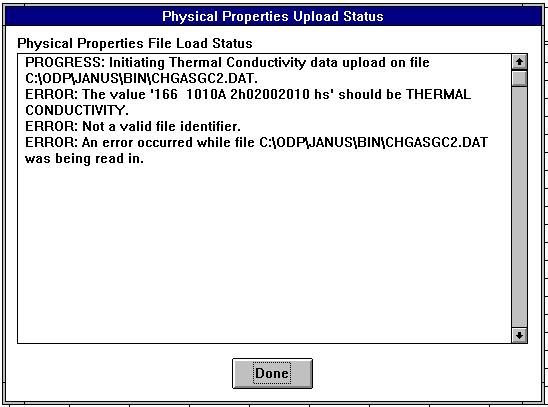
Physical Properties Upload Status Window
The window displays the status of a file as it is loaded. When errors are encountered, that error is displayed in this window and the read process is aborted.
Buttons
 This button exits the window.
This button exits the window.
1.3 Input/Edit
The Input/Edit menu contains one option.

1.3.2 Edit/Delete Section/Data (Change/Delete Data Window -- mst09)
The Change/Delete Data window is used to edit or delete physical properties data. Open the window by selecting the Edit/Delete Section option in the Input/Edit menu. There are several submenu options. All of the options that fall under this menu open the Change/Delete Data window. The type you select to edit in the window appears in the title of the window.
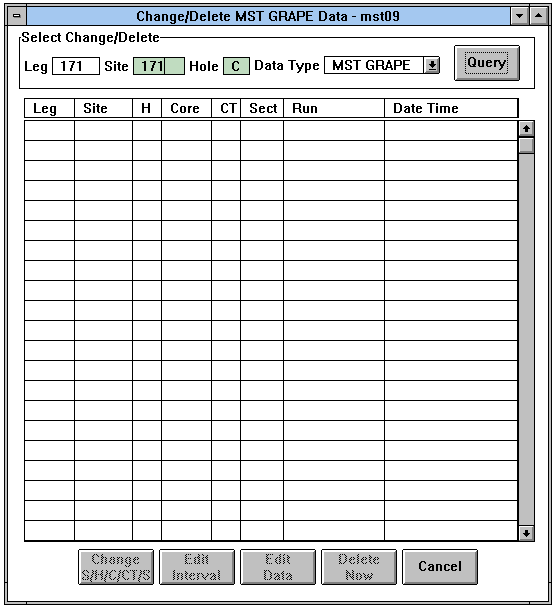
Change/Delete Data Window
When the window opens it is blank. The current leg is displayed and all of the buttons except the Cancel button are unavailable.
In the Select Change/Delete panel, enter the site and hole of the data you wish to edit and select the type of data in the the Data Type choice box. Click on the Query button. The system retrieves the data and loads it into the list box. After the system retrieves the data, the window name in the title bar changes to reflect the Data Type selected.
There are three different editing functions that you can do, depending on the type of data. You can change the site, hole, core, core type, and section for all data types. Some data types allow editing of the interval, and others allow editing of the other data. A row of data can be deleted for any data type. Each data type has different data that can be edited. The data that can be edited was determined by the ODP Steering Committee.
To edit data, select the row that contains the data. The buttons that correspond to the editing functions that you are allowed to perform for this data become active. Click on the appropriate button. When you do this, a popup appears in which to make the allowed changes.
To delete a row of data, select it and click on the Delete Now button. The data is immediately deleted from the list box and the database.
To edit the site, hole, core, coretype, or section, click on the Change S/H/C/CT/S button. The popup displays the current site, hole, core, core type, and section in the Change From panel. In the Change To panel, enter the new values for site, hole, core, core type, and/or section. Then click on the OK button to save the changes to the database. The Change/Delete Data window returns and displays the changes.
To edit an interval, click on the Edit Interval button. This brings up the Edit Interval popup which displays the current interval for the selected row of data. Select the intervals and enter the new values. Click on the OK button to save the changes to the database. The Change/Delete Data window returns.
To edit data (depending on the data type), click on the Edit Data button. This opens a different popup, depending on the data type being edited. The current values are displayed and blank fields for the new values appear beneath them.
Buttons
 This button accesses the Change S/H/C/CT/S panel in which to change the site, hole, core, core type, and/or section for a selected row of data. The OK button in the panel saves the changes to the database and returns the Change/Delete Data window. The Cancel button closes the panel without saving any changes.
This button accesses the Change S/H/C/CT/S panel in which to change the site, hole, core, core type, and/or section for a selected row of data. The OK button in the panel saves the changes to the database and returns the Change/Delete Data window. The Cancel button closes the panel without saving any changes.
 Clicking on this button opens the Change Interval panel in which to change top and/or bottom intervals for the selected row of data. The OK button in the panel saves the changes to the database and returns the Change/Delete Data window. . The Cancel button closes the panel without saving any changes.
Clicking on this button opens the Change Interval panel in which to change top and/or bottom intervals for the selected row of data. The OK button in the panel saves the changes to the database and returns the Change/Delete Data window. . The Cancel button closes the panel without saving any changes.
 Use this button to access the Edit Data popup containing the specific data that can be edited. The OK button in the panel saves the changes to the database and returns the Change/Delete Data window. . The \4 Cancel\0 button closes the panel without saving any changes.
Use this button to access the Edit Data popup containing the specific data that can be edited. The OK button in the panel saves the changes to the database and returns the Change/Delete Data window. . The \4 Cancel\0 button closes the panel without saving any changes.
 When you click on this button, the selected row of data is immediately deleted from the database and the list box.
When you click on this button, the selected row of data is immediately deleted from the database and the list box.
 This button closes the window.
This button closes the window.
1.4 Reports
The Reports menu contains the following option:
1.4.1 Pick List (Report Pick List -- Window par06)
The Report Pick List window is used to select and view reports for each application. Access the window by selecting the Pick List option from the Reports menu.
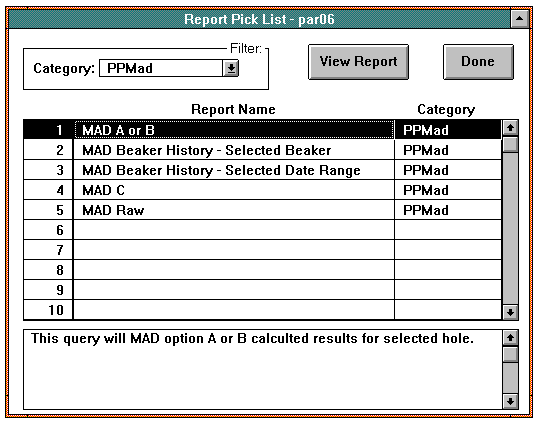
Report Pick List Window
When the window opens, the category selected in the Filter panel defaults to PPMAD. The list box contains the names of all Physical Properties-related reports (PPMAD and PPPWSAVS). The panel at the bottom shows a brief description of the information in the highlighted report. You can see a list of reports for another application by selecting that application in the Filter panel.
NOTE: Most Janus reports were created with an independent application called Business Objects. These reports are listed and defined in Appendix D - Business Object Reports of the Functional Specifications.
Buttons
 Clicking on this button opens the Business Objects
Clicking on this button opens the Business Objects
TM application and the report that was highlighted in the list box automatically opens through Business Objects. NOTE: For help on manipulating these reports, please refer to the Business Objects Userís Manual or the on-line help. When you close the report, Janus returns.
 This button exits the window.
This button exits the window.
Back to JANUS Applications

![]()






